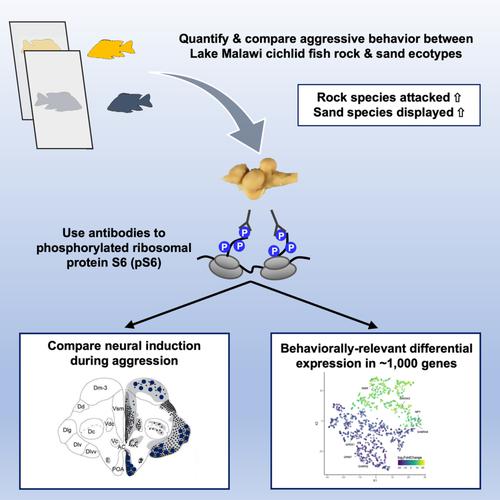当前位置:
X-MOL 学术
›
Genes Brain Behav.
›
论文详情
Our official English website, www.x-mol.net, welcomes your
feedback! (Note: you will need to create a separate account there.)
Ecotype differences in aggression, neural activity and behaviorally relevant gene expression in cichlid fish.
Genes, Brain and Behavior ( IF 2.4 ) Pub Date : 2020-04-22 , DOI: 10.1111/gbb.12657 Nicole M Baran 1, 2 , J Todd Streelman 1, 3
Genes, Brain and Behavior ( IF 2.4 ) Pub Date : 2020-04-22 , DOI: 10.1111/gbb.12657 Nicole M Baran 1, 2 , J Todd Streelman 1, 3
Affiliation

|
In Lake Malawi, two ecologically distinct lineages of cichlid fishes (rock‐ vs sand‐dwelling ecotypes, each comprised of over 200 species) evolved within the last million years. The rock‐dwelling species (Mbuna ) are aggressively territorial year‐round and males court and spawn with females over rocky substrate. In contrast, males of sand‐dwelling species are not territorial and instead aggregate on seasonal breeding leks in which males construct courtship “bowers” in the sand. However, little is known about how phenotypic variation in aggression is produced by the genome. In this study, we first quantify and compare behavior in seven cichlid species, demonstrating substantial ecotype and species differences in unconditioned mirror‐elicited aggression. Second, we compare neural activity in mirror‐elicited aggression in two representative species, Mchenga conophoros (sand‐dwelling) and Petrotilapia chitimba (rock‐dwelling). Finally, we compare gene expression patterns between these two species, specifically within neurons activated during mirror aggression. We identified a large number of genes showing differential expression in mirror‐elicited aggression, as well as many genes that differ between ecotypes. These genes, which may underly species differences in behavior, include several neuropeptides, genes involved in the synthesis of steroid hormones and neurotransmitter activity. This work lays the foundation for future experiments using this emerging genetic model system to investigate the genomic basis of evolved species differences in both brain and behavior.
中文翻译:

慈鲷鱼在攻击,神经活动和行为相关基因表达方面的生态型差异。
在马拉维湖,在过去一百万年中演化出了两种在生态学上不同的丽鱼科鱼类(岩栖生态型和沙栖生态型,每种都有200多种物种)。岩栖物种(姆布纳)一年四季都在领土上争分夺秒,雄性朝上,雌性在坚硬的地基上方产卵。相反,居住在沙地中的雄性不是地域性的,而是聚集在季节性繁殖地上,在这种情况下,雄性在沙地中建立求偶“吹牛者”。然而,对于基因组如何产生侵略性的表型变异知之甚少。在这项研究中,我们首先对7个丽鱼科鱼物种的行为进行了量化和比较,证明了在无条件的镜面攻击下的实质生态类型和物种差异。其次,我们比较了两种代表性物种Mchenga conophoros(沙栖)和Petrotilapia chitimba的镜像引起的攻击中的神经活动。(岩石住所)。最后,我们比较了这两个物种之间的基因表达模式,特别是在镜子攻击过程中激活的神经元内。我们鉴定出大量基因在镜像引起的侵略中表现出差异表达,以及许多生态型之间存在差异的基因。这些基因可能在行为上可能存在物种差异,其中包括几种神经肽,参与类固醇激素合成和神经递质活性的基因。这项工作为使用这种新兴的遗传模型系统研究大脑和行为方面进化物种差异的基因组基础奠定了基础。
更新日期:2020-04-22
中文翻译:

慈鲷鱼在攻击,神经活动和行为相关基因表达方面的生态型差异。
在马拉维湖,在过去一百万年中演化出了两种在生态学上不同的丽鱼科鱼类(岩栖生态型和沙栖生态型,每种都有200多种物种)。岩栖物种(姆布纳)一年四季都在领土上争分夺秒,雄性朝上,雌性在坚硬的地基上方产卵。相反,居住在沙地中的雄性不是地域性的,而是聚集在季节性繁殖地上,在这种情况下,雄性在沙地中建立求偶“吹牛者”。然而,对于基因组如何产生侵略性的表型变异知之甚少。在这项研究中,我们首先对7个丽鱼科鱼物种的行为进行了量化和比较,证明了在无条件的镜面攻击下的实质生态类型和物种差异。其次,我们比较了两种代表性物种Mchenga conophoros(沙栖)和Petrotilapia chitimba的镜像引起的攻击中的神经活动。(岩石住所)。最后,我们比较了这两个物种之间的基因表达模式,特别是在镜子攻击过程中激活的神经元内。我们鉴定出大量基因在镜像引起的侵略中表现出差异表达,以及许多生态型之间存在差异的基因。这些基因可能在行为上可能存在物种差异,其中包括几种神经肽,参与类固醇激素合成和神经递质活性的基因。这项工作为使用这种新兴的遗传模型系统研究大脑和行为方面进化物种差异的基因组基础奠定了基础。











































 京公网安备 11010802027423号
京公网安备 11010802027423号